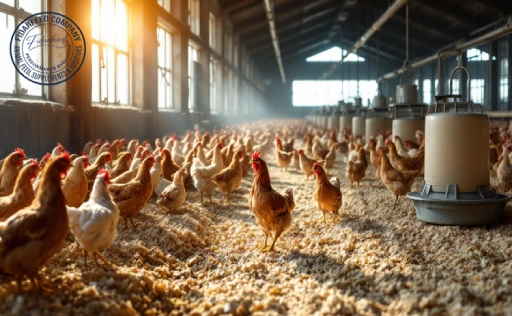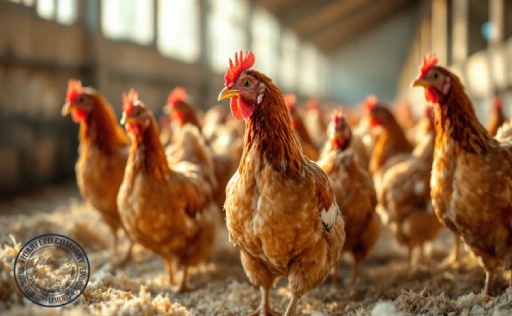Why Broiler House Ventilation Matters for Healthy Flocks
Broiler house ventilation is one of the most crucial factors in poultry farming, directly impacting bird health, growth rate, and overall productivity. A well-ventilated environment ensures fresh air circulation, removes excess moisture, and prevents harmful gas buildup, reducing the risk of respiratory diseases and stress in broilers.
Poor ventilation can lead to serious problems, such as high ammonia levels, heat stress, and uneven air distribution, all of which negatively affect feed conversion ratios and weight gain. Whether you’re an experienced breeder or just starting out, understanding and optimizing ventilation can make a significant difference in your flock’s well-being and profitability.
Key Principles of an Effective Broiler House Ventilation System
To create an ideal environment, broiler house ventilation must balance three key elements: air exchange, temperature regulation, and humidity control. The goal is to provide a steady flow of fresh air while preventing drafts and temperature fluctuations that could stress the birds.
Learn more about: Probiotic Supplement for Poultry
Effective ventilation systems help maintain a stable microclimate inside the poultry house, ensuring that oxygen levels are sufficient while harmful gases like carbon dioxide and ammonia are expelled. Additionally, proper humidity control prevents excessive moisture buildup, which can lead to wet litter, increasing the risk of bacterial and fungal infections.
Natural vs. Mechanical Ventilation: Which One is Best?
Choosing the right ventilation system depends on factors like climate, housing structure, and flock size.
- Natural Ventilation: Uses sidewall openings, ridge vents, and wind pressure to drive airflow. It is cost-effective and works well in moderate climates but can be difficult to control during extreme weather conditions.
Learn more about: Meat Meal vs. Soybean Meal: Unlocking Superior Nutritional Benefits for Broiler Chicks
- Mechanical Ventilation: Relies on fans, tunnel ventilation, and controlled airflow systems to regulate temperature and humidity precisely. This method is ideal for large-scale poultry farms and regions with unpredictable weather, as it provides more consistent results.
For many commercial broiler operations, a combination of natural and mechanical ventilation—known as hybrid ventilation—offers the best of both worlds, ensuring optimal airflow under varying conditions.
How to Optimize Airflow for Maximum Broiler Performance
Optimizing airflow is critical for bird comfort and growth. Here’s how you can improve ventilation efficiency:
- Proper Fan Placement: Ensure that exhaust fans are positioned to create uniform air distribution throughout the house. Avoid dead spots where air movement is minimal.
Learn more about: Complete Guide to the Management of Breeding Stock and Broilers
- Correct Inlet Design: Air inlets should direct fresh air across the ceiling before it reaches the birds, preventing direct drafts while ensuring even temperature distribution.
- Regular System Maintenance: Clean fans, adjust inlets, and check for blockages regularly to prevent airflow disruptions and maintain efficiency.
A well-optimized ventilation system helps broilers maintain body temperature, reducing stress and promoting better feed conversion rates.
Managing Ammonia, Moisture, and Air Quality
Poor air quality is a silent killer in broiler production. High ammonia levels, excess moisture, and poor ventilation create an unhealthy environment that can lead to respiratory issues, poor growth, and increased mortality rates.
- Controlling Ammonia: Regularly monitor ammonia levels and take action when they exceed 20 ppm. Using proper litter management, such as adding fresh bedding and implementing drying techniques, helps reduce ammonia production.
Learn more about: Probiotics’ Effect on Egg Production: Boosting Naturally
- Regulating Humidity: The ideal relative humidity for a broiler house is between 50-70%. Too much moisture encourages bacterial growth, while excessively dry air can cause respiratory irritation.
- Ensuring Clean Air: Maintain proper airflow rates to remove dust and airborne pathogens, minimizing disease risks and enhancing bird comfort.
Seasonal Ventilation Adjustments: What You Need to Know
Ventilation needs change with the seasons, and adjusting your system accordingly can prevent health issues and production losses.
- Summer Ventilation: Use tunnel ventilation or evaporative cooling pads to prevent heat stress. Increase fan speeds and maximize airflow to maintain optimal temperatures.
Learn more about: How to Breed Broilers at Home: A Step-by-Step Beginner’s Guide
- Winter Ventilation: Reduce excessive heat loss while ensuring fresh air exchange. Minimum ventilation strategies help maintain air quality without causing drafts that could chill the birds.
Adapting to seasonal shifts ensures year-round flock comfort, leading to consistent weight gain and better overall health.
Common Ventilation Mistakes and How to Avoid Them
Even with the best equipment, mistakes in ventilation management can lead to poor performance. Here are some common errors and solutions:
- Inadequate Airflow Management: Failing to balance inlet openings and fan output can cause air stagnation. Regularly check and adjust settings to ensure even distribution.
- Neglecting Maintenance: Dirty fans and clogged inlets reduce efficiency. Implement a routine cleaning schedule to keep the system running smoothly.
- Overlooking Humidity Control: High moisture levels lead to wet litter, increasing the risk of disease. Use proper ventilation and heating to maintain ideal conditions.
Learn more about: Mastering the Basics: A Comprehensive Broiler Breeder Management Guide
Final Tips for a Well-Ventilated Broiler House
For optimal broiler performance, follow these best practices:
- Monitor temperature, humidity, and ammonia levels daily.
- Ensure ventilation settings match seasonal conditions.
- Regularly maintain equipment to prevent airflow restrictions.
- Train farm staff on proper ventilation management techniques.
By prioritizing broiler house ventilation, you can create a healthier environment, improve feed efficiency, and maximize production outcomes. Have any insights or experiences to share? Drop your thoughts in the comments below!








